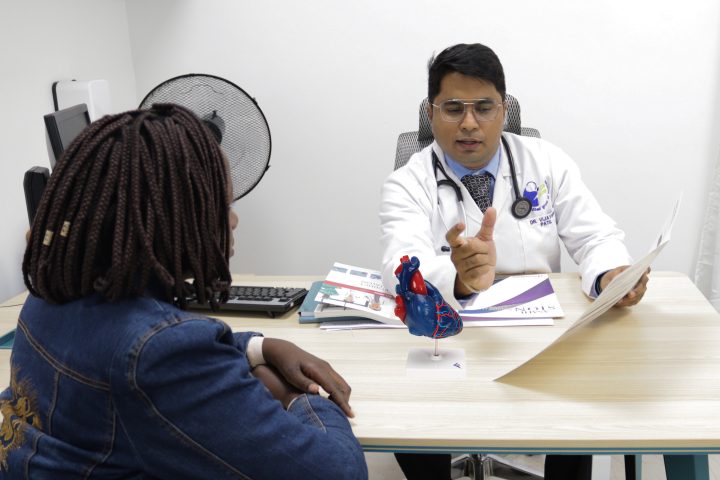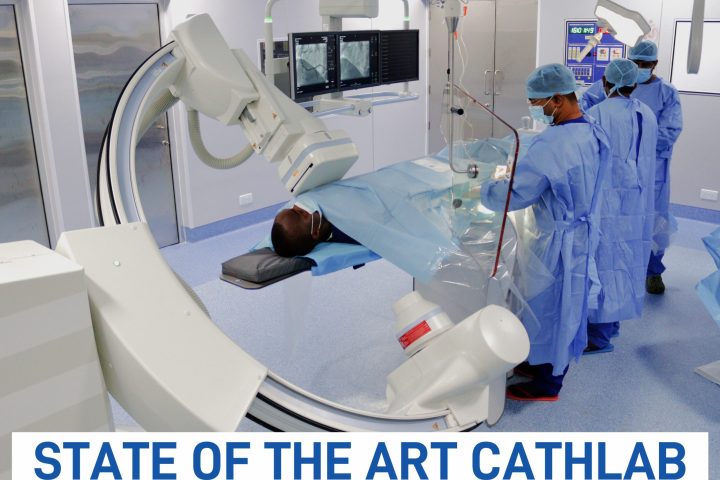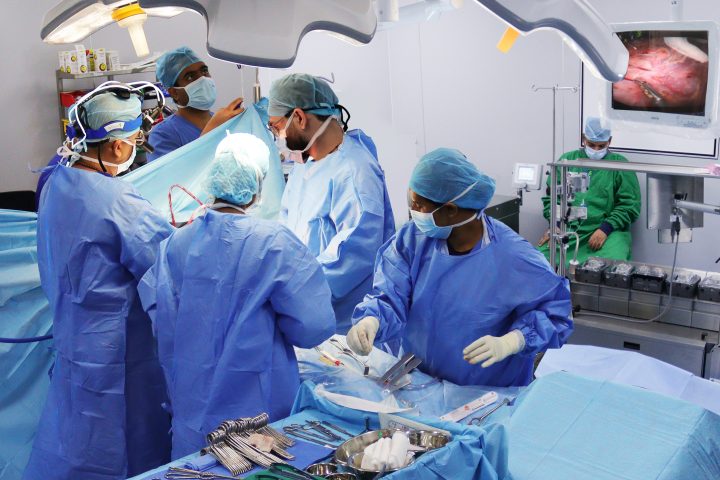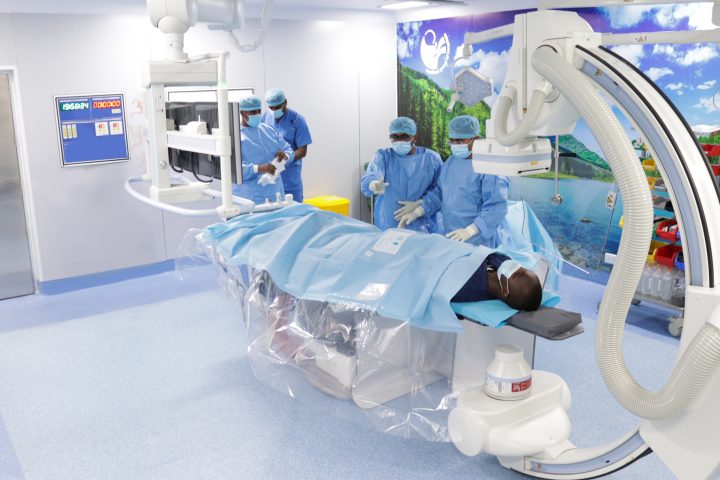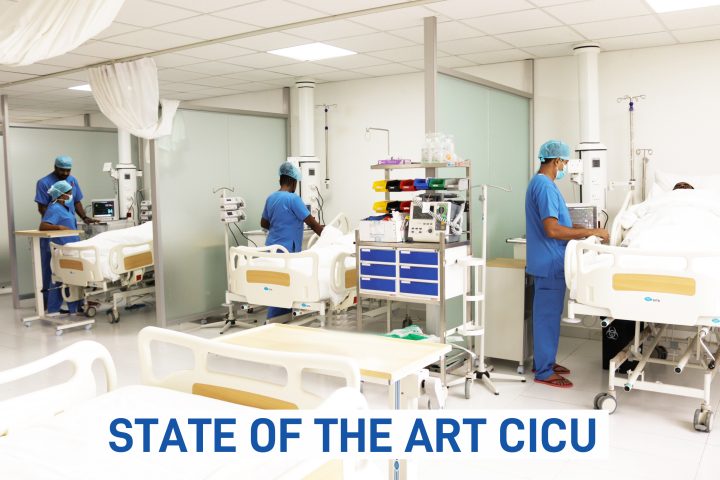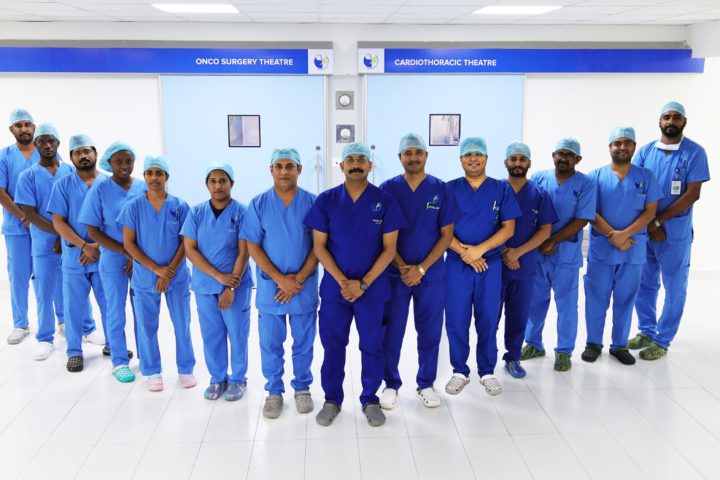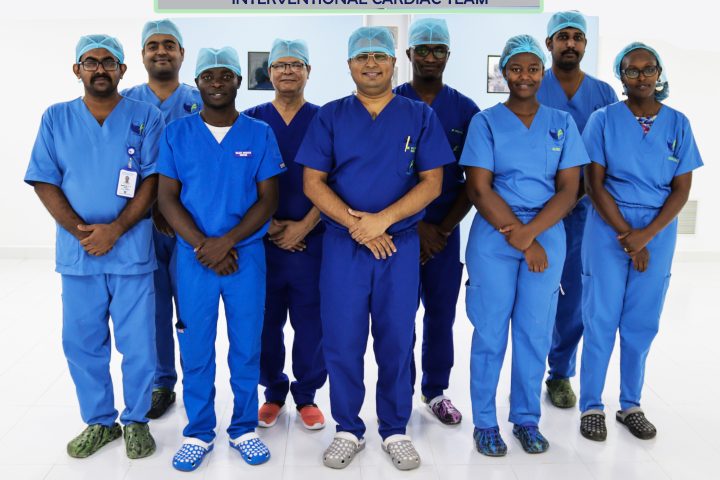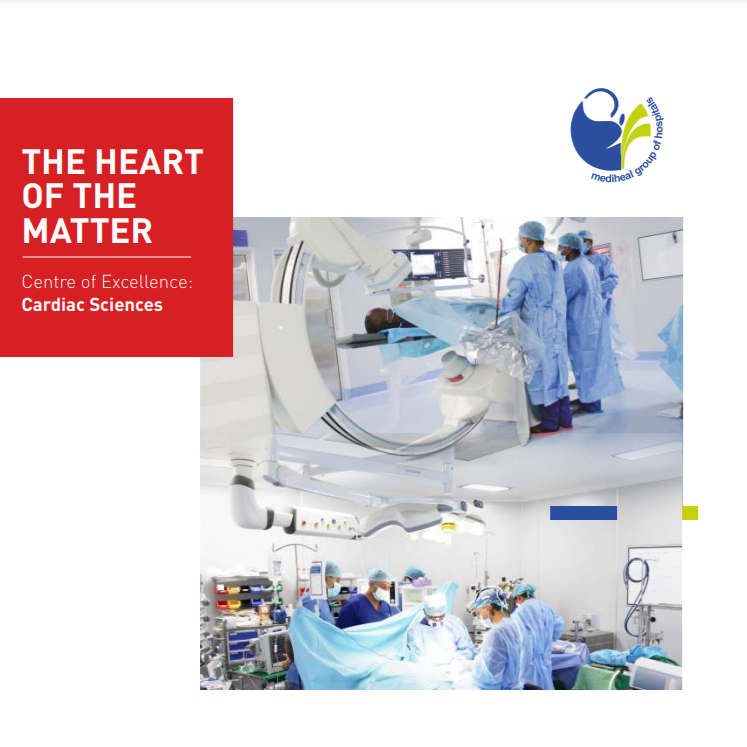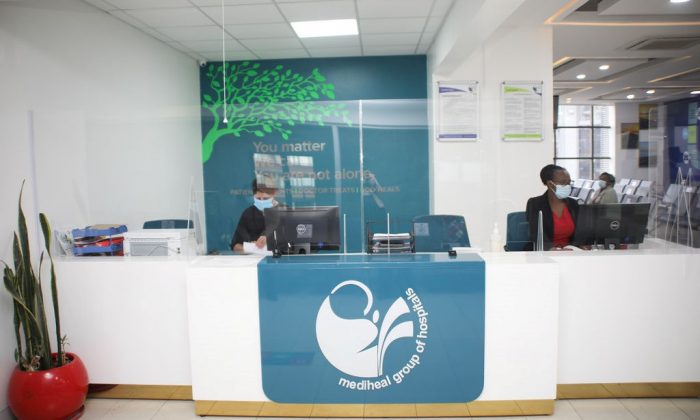Cardiac Sciences
INTERVENTIONAL CARDIOLOGY
Cardiology deals with all heart and blood vessels related diseases. The main burdens are coronary artery diseases and valvular diseases. We are experts in all kinds of heart and blood vessels related procedures like angiography, angioplasty, etc. Mediheal is a state of art cardiac care unit in Africa.
Following are main streams in cardiac interventions:
- Coronary artery disease procedures
- Structural heart disease (including paediatric) procedures
- Peripheral Vascular procedures
- Electrophysiological procedures
- Coronary artery procedures:
- Coronary angiography
- Coronary angioplasty
- Complex Angioplasty
- Primary angioplasty,
- Bifurcation angioplasty
- CTO interventions
- SVG, LIMA interventions
- Rota ablation, IVL interventions
- Imaging like IVUS, OCT, FFR guided PTCA
- Bioabsorbable stent placement
- Structural heart interventions:
- Congenital heart disease interventions
- ASD/VSD/PDA device closure
- Vascular closure for aneurysms and malformations
- Valvular interventions
- Balloon Mitral valvuloplasty (BMV)
- Balloon Pulmonary valvuloplasty (BPV)
- Balloon Aortic and tricuspid valvuloplasty
- Percutaneous Aortic valve replacement (TAVI), Mitra clip
- Congenital heart disease interventions
- Peripheral Interventions
- Peripheral angiography-
- Aortography, Upper limb & lower limb angiography, Renal angiography, cerebral angiography
- Peripheral angioplasty
- Subclavian angioplasty
- Renal angioplasty
- Carotid angioplasty
- Peripheral angioplasty limb vessels iii. Aortic interventions
- Aortic stent-graft
- Coarctation stenting
- DVT & Pulmonary embolism interventions
- Peripheral angiography-
- Electrophysiological or conduction abnormality procedures
-
- Single and double chamber Pacemaker
- Single and double chamber Defibrillator (AICD)
- CRT (Cardiac resynchronization therapy)
- Implantable cardiac monitors
- Leadless pacemaker
CARDIAC NON-INVASIVE PROCEDURES
- 2D Echocardiography
- Transesophageal echocardiography
- Dobutamine stress echocardiography
- Holter monitoring
- Ambulatory BP monitoring
- TMT- Trade mill test (stress exercise test)
Adult and Pediatric Cardiac Surgery
When it comes to matters requiring surgery of the heart as well as the lungs, blood vessels, and all the contents of the chest, it should be treated as very delicate, and as such you should seek out the best Cardiovascular & Thoracic surgeons in your locality or anywhere in the world, who have the requisite expertise to deliver the highest quality of surgical care. The world-class Cardiovascular and Thoracic surgeons’ team at Mediheal Group of Hospitals has tremendous individual and collective experience with the treatment of thousands of cardiac and thoracic surgical patients, ranging from neonates to older adults. They perform some of the world’s most advanced cardiac surgeries in technologically advanced high-end operating suites. These include lifesaving emergency and elective cardiac procedures including Adult cardiac surgery, Complex pediatric (congenital) cardiac surgery, heart valve surgery, complex repair of abdominal and thoracic aortic aneurysms, Thoracic surgeries, vascular and endovascular surgeries.
Our Intensive Care Unit (ICU) is designed specifically for the care of our postoperative cardiac, thoracic and vascular surgery patients. Our state-of-the-art facility provides round-the-clock individualized care, supervised by specially trained ICU doctors (intensivists) and nurses. From adults suffering from coronary artery disease to children suffering from a wide range of heart defects and conditions, we offer a complete scope of cardiovascular surgery services.
Personalized Cardiac Surgery Expertise
The cardiovascular surgeons at Mediheal consistently rank among the best in the world. Our medical technology, world-class medical facilities, and stellar track record in positive patient outcomes make us the leading destination for expert cardiac surgical care. From the very first time that you contact Mediheal hospital, a member of our Patient Care Relations Team will be your guide either virtually or in person. Each member of our team is committed to easing your anxiety, addressing worries, and ensuring that every patient has a successful healthcare journey while receiving care with us.
Your health concierge will assist you in the following ways:
Coordinate medical intake sessions via Skype and/or teleconference calls Schedule an intake session with your primary care physician and/or other care providers, as needed
Arrange all medical appointments, admissions, and discharge details
Ensure seamless communications between you, your family, and our medical staff
Serve as a single-point-of-contact for administrative matters
Manage billing and payment
Answer non-medical procedural questions
A Resource for Adult Cardiac Surgery
Mediheal has earned distinction in cardiovascular and thoracic surgery and the care of complex cardiac conditions. Each cardiovascular procedure is performed with precision and exacting standards of excellence and patient safety, all geared towards excellent treatment outcomes. Whenever possible, our surgical team chooses minimally invasive or key-hole procedures with added benefits of earlier recovery and return to full function. If a more invasive approach is required, our team uses clinically advanced best practices to reduce risk, prevent infection and other complications, and promote good outcomes.
The range of Cardiovascular and Thoracic Surgical services we offer include:
(A) ADULT CARDIAC PROCEDURE
(1) Coronary Artery Bypass Surgery
Coronary Artery bypass grafting (CABG)
When normal blood flow to the heart is partially obstructed due to coronary (heart) artery blockage (what is commonly known as arteriosclerosis), bypass surgery is often the best solution. CABG treats blocked heart arteries by creating new passages for blood to flow to the heart muscle. Other arteries or veins from the patient’s body are used to create grafts that reroute the blood around the blocked heart artery. A patient may undergo one, two, three, or more bypass grafts, depending on how many coronary arteries are blocked. CABG is one of the most standard and effective procedures to improve the supply of blood and oxygen to the heart, relieve chest pain, reduce the risk of heart attack, and improve the patient’s ability to engage in physical activity. This is performed both using traditional techniques requiring heart-lung machine support or without it (Off-pump CABG) as well as via a minimally-invasive approach.
CABG using the conventional heart-lung machine:
Traditionally, coronary artery bypass surgery is performed with the assistance of a heart-lung machine which allows the heart to be stopped so that the surgeon can operate on a surface that is blood-free and still. The heart-lung machine maintains circulation despite the lack of a heartbeat, removing carbon dioxide from the blood and replacing it with oxygen before pumping it around the body.
CABG beating heart technique:
In this technique of performing CABG, the heart-lung machine/pump is not used i.e., Off-Pump CABG (OPCAB). Here, instead of stopping the heart, the area where the anastomosis is performed is stabilized with advanced instruments while the rest of the heart beats normally, pumps blood, and circulates blood to the entire body.
Total arterial revascularization: LIMA-RIMA-Y Technique:
In this technique right internal mammary artery (RIMA) is attached to the left internal mammary (LIMA) in an inverted Y configuration. Then multiple bypasses are done with LIMA and RIMA. Studies show that total arterial revascularization provides better long-term survival than a single arterial graft. Survival is improved when a right internal mammary artery (RIMA) is used than radial artery as a second conduit when performing CABG for multi-vessel disease. More than 50% of CABGs done by us are done using a total arterial technique with both internal mammary arteries.
Left internal mammary artery (LIMA)
Over the last two decades, many studies have shown better long-term outcomes and survival in patients undergoing CABG with LIMA to the left anterior descending artery (LAD). Worldwide, LIMA is considered the gold standard for surgical revascularization and its usage has been steadily increasing
Right internal mammary artery (RIMA)
Survival is improved when the right internal mammary artery (RIMA) rather than the radial artery is used as the second conduit when performing CABG for multi-vessel disease. Studies show that total arterial revascularization provides better long-term survival than a single arterial graft
Minimally invasive CABG
Minimally invasive coronary artery bypass (MIDCAB) is an option for some patients who require CABG. The benefits of minimally invasive surgery include a smaller incision (3 to 4 inches instead of the 6- to 8-inch incision with traditional surgery) and smaller scars. Other possible benefits include a reduced risk of infection, less bleeding, less pain and trauma decreased length of stay in the hospital, and decreased recovery time.
CABG with associated procedures
A variety of surgical procedures are combined with CABG like valve repairs and replacements, correction of structural defects of the heart, ventricular aneurysms repair, carotid artery bypass, etc. These procedures are combined when an individualized patient treatment plan is developed
Redo CABG
Repeat cardiac operations are technically more demanding due to the higher risk profile of the patients. This is usually performed in patients who had previous heart surgery and presents with symptoms that are not relieved by other modalities of treatments.
Hybrid CABG
This is an alternative to traditional bypass surgery usually performed in patients who are at high risk for conventional CABG. In this procedure, coronary artery bypass grafting and stenting are performed during the same procedure. In high-risk patients, hybrid CABG has been shown to result in less pain and quicker recovery time. The most important requirement for performing this procedure is a highly sophisticated operating room called a ‘HYBRID LAB’. Mediheal is the only hospital in East Africa with a standard hybrid lab.
(2) Heart Valve Surgery
Valvular heart disease occurs when one or more of the four heart valves (mitral, aortic, tricuspid, or pulmonary) is not working or functioning properly. In Africa and many other parts of the world, Rheumatic heart disease (RHD) remains a leading cause of heart valve disease with varying involvement of the heart and a wide range of clinical presentations. The cardiac surgeons at Mediheal Hospital have tremendous capacity and many years of experience with repairing and replacing all four types of heart valves as well as with performing redo heart valve surgeries.
Heart Valve Surgery
Valve surgery can be broadly divided into 1) repair surgery and 2) replacement surgery. The clinical evaluation and various tests determine the best type of procedure for you. Other factors influencing the decision are the structure of your heart, your age, other medical conditions you have, and your lifestyle. Valve surgery may be combined with other heart surgeries also.
Mitral Stenosis
The Mitral valve between the left atrium and left ventricle is the most common valve which is affected by infection – like Acute Rheumatic fever (ARF). This infection often led to mitral stenosis-narrowing of the valve. That can progressively lead to pulmonary congestion, irregular heart rhythm, and heart failure, if untreated. The valve can be opened by specially designed balloons in our Cathlab (Minimally-invasive). If it is not possible to open by a balloon catheter, then surgery is required to repair or replace the valve.
Mitral Regurgitation
When the mitral valve – which guards the left atrium (LA) to left ventricle (LV) blood flow – does not close tightly, it can leak blood back into the left atrium and cause extra load on the heart. For severe leaks, the valve has to either be repaired or replaced. Our surgical team has vast expertise in repairing the mitral valve, which can allow the patient to avoid artificial replacement of the valve and the permanent need for blood thinners. Where this is impossible, we also have the expertise to replace the valve and manage the patient in the long term.
Aortic Valve stenosis
This valve abnormality involves the major valve on the outlet from the left side of the heart. This is more dangerous as it affects the flow of oxygen-rich blood into the major vessel carrying blood to the whole body (Aorta) including the heart itself and the brain. In this condition, the valve becomes too tight, doesn’t open freely, or is too narrow. Correcting this problem may require opening the valve by specially designed balloons or replacement with a minimally-invasive approach (a novel procedure called TAVI) in the Cathlab. However, were impossible, the patient will require surgery to either repair or replace the valve.
Aortic Regurgitation
Here the blood leaks back from the aorta to the left ventricle after being pumped out from the left side of the heart, causing the left ventricle to dilate and if not treated lead to heart failure. This could be caused by various conditions, such as bicuspid aortic valve, Marfan syndrome, and Rheumatic Heart disease (RHD). The treatment is to repair or replace the valve. Our surgical team has extensive experience and expertise in treating a wide range of diseases of the aortic valve.
Double valve replacement
In this surgery, both valves (mitral and aortic) of the left heart are replaced with an artificial valve. The valve replacement helps to prevent further damage to the heart or a heart infection.
Tricuspid Valve repair
The tricuspid valve is situated on the right side of the heart and leakage of this valve is associated with mitral valve disease. It can be treated with tricuspid valve repair/replacement.
Homograft valve replacement
A homograft is donated from a cadaver to be used during complex reconstructive surgery. It typically includes human heart valves and arteries.
ROSS procedure
This is a complex surgery that can be very effective for treating a damaged aortic valve, especially in younger patients. Here, the patient’s damaged aortic valve is replaced with his pulmonary valve, and a treated valve from a cadaver is used in the place of the pulmonary valve. Generally, this is an effective procedure for maintaining long-term wellness without the need for ongoing medications like a blood thinner. Very few centers around the world can complete this complex procedure. The cardiac team at Mediheal has the expertise to perform this procedure.
Valve replacement with cardiac ablation
When medication is ineffective or cannot be tolerated by patients with arrhythmias (usually atrial fibrillation), a non-surgical procedure called cardiac ablation may be performed. This procedure is frequently performed with a CABG or valve replacement. The surgeon can use small incisions, radio waves, freezing, microwave energy, or ultrasound energy to create scar tissue. The scar tissue, which does not conduct electrical activity, blocks the abnormal electrical signals causing the arrhythmia
Surgery for Infective endocarditis
Infective endocarditis of valves is most often due to bacterial infection. It can affect the native valves or prosthetic valves. Many a time, the treatment requires the replacement of the affected valve. The surgery for infective endocarditis is very complex and technically demanding. This may require the use of homograft to reduce the chance of further infection. Mediheal offers surgical treatment for infective endocarditis.
Redo valve surgery
When initial valve surgery fails, redo valve surgery may be medically warranted to improve, and/or save the life of the patient. These surgeries are even more complex than first surgeries, due to scar tissue and other underlying conditions of the people who need this treatment. People who come back for a second or even third heart surgery need surgeons with a highly advanced set of surgical skills and techniques. Mediheal surgeons are experts in cardiac reoperations and they do it regularly.
(3) Aortic Surgery
We have a specialized team highly experienced in treating all types of aortic diseases like aneurysms, dissections, trauma, etc. We use advanced treatment options like Endovascular Aneurysm Repair (EVAR), debranching of the aortic arch, and Reno visceral debranching, for treating these conditions. Our sophisticated and very advanced hybrid lab is well-positioned to seamlessly carry out these procedures at a single stage instead of multiple sittings.
Aortic root replacement (Bentall’s Procedure)
This specialized complex cardiac surgery involves the replacement of the damaged aortic valve, aortic root, and ascending aorta along with re-implantation of coronary arteries into the graft. The mediheal cardiac team has the expertise to perform this complex procedure.
Valve-sparing aortic root replacement
In this procedure, the patient’s aortic valve is kept intact, although it may be repaired, reimplanted, and reconnected to a new section of aortic tissue. By preserving the natural aortic valve, the patient avoids the need for lifelong anticoagulation therapy, such as the medication warfarin.
Surgical repair of all types of aneurysms
Diseases of the aorta not involving the aortic valve can be surgically managed by repairing the aorta or replacing the diseased segment with a synthetic material. We have sufficient experience at Mediheal to carry out these procedures using the most modern techniques.
Emergency surgery for aortic dissection
The aorta is the main artery that carries blood away from the heart to the rest of the body. When an aortic dissection occurs, the blood being pumped forcefully through the aorta splits the layers of the artery wall, allowing a build-up of blood to continually leak into the space. This further splits the artery wall, trapping the blood that is coming from the heart. This is a medical emergency that requires a rapid response and surgical intervention to repair the aorta. The team at Mediheal is always on stand-by to safely manage both Acute (emergency) and Elective (Chronic) aorta dissections.
Surgery for aortoarteritis (Takayasu’s disease)
This is a chronic inflammatory disease involving the aorta, the arteries arising from the aorta, and often, the pulmonary arteries. The inflammation leads to stenosis, occlusion of the involved artery, and/or aneurysm formation. There are various types of this disease, but all are serious and can have life-threatening consequences if not appropriately diagnosed and treated. Treatment is a three-step process, as follows. First, the immune reaction that has caused the damage is suppressed with corticosteroids such as prednisone. Second, infections are brought under control using antibiotics. Finally, surgery may be performed to repair the aorta and any other organs that may have been damaged
(4) Arrhythmia surgery for atrial fibrillation
Pulmonary vein isolation
In this procedure all four (4) pulmonary veins are isolated from the left atrium by creating a surgical scar between them. The scar tissue, which does not conduct electrical activity, blocks the abnormal electrical signals causing the arrhythmia.
MAZE procedure
When medication is ineffective or cannot be tolerated by patients with arrhythmias (usually atrial fibrillation), a non-surgical procedure called cardiac ablation may be performed. This procedure is frequently performed with a CABG or valve replacement. The surgeon can use small incisions, radio waves, freezing, microwave energy, or ultrasound energy to create scar tissue. The scar tissue, which does not conduct electrical activity, blocks the abnormal electrical signals causing the arrhythmia.
(5) Surgery for Heart Failure
Surgery for Ventricular aneurysm
A ventricular aneurysm is a complication of a heart attack that develops after a few days or weeks. Here, a portion of the heart musculature thins out and bulges leading to heart failure and arrhythmias. At Mediheal, surgical remodeling of the left ventricle can be combined with revascularization procedures to permanently treat this patient.
Left ventricular assist device (LVAD) implantation
One of the most groundbreaking improvements for heart failure patients is LVAD. The LVAD is a mechanical pump that is implanted inside a patient’s chest to help a weakened heart ventricle pump blood throughout the body. It is used as a bridge to transplantation, and also as destination therapy. Destination therapy offers long-term support to terminally ill patients whose health makes them ineligible for heart transplantation. Health City Cayman Islands performed the very first LVAD procedure ever done in the Caribbean in August 2014 and performed a second successful LVAD procedure in December of that year.
Studies have demonstrated that permanent LVAD devices doubled the one-year survival rate of patients with end-stage heart failure, compared to medication therapy alone.
However, implantation comes with risks including infection, stroke, and bleeding. Patients requiring this intervention can get it done at Mediheal.
(6) Surgery for resection of cardiac tumors e.g., Atrial myxomas, cardiac cysts, etc.
(7) Other Complex Cardiac Surgeries
Pulmonary thromboendarterectomy (PTE)
This is a surgical procedure that removes organized clotted blood (thrombus) from the pulmonary arteries. The surgery is performed to improve blood flow and normal gas exchange of the blood so that the patient can breathe easier. It prevents heart failure and premature death, alleviates stress on the right side of the heart by correcting pulmonary hypertension, and improves the patient’s quality of life.
PTE is an 8 to 10-hour procedure that involves opening the chest and attaching the patient to a heart-lung machine, then cooling the patient’s body to about 64 to 68 degrees Fahrenheit. The cold temperature reduces the body’s need for oxygen and provides organ protection. During the critical parts of the surgery, the surgeons turn off the heart-lung machine, stopping heart circulation for up to 20 minutes to create a bloodless surgical field. Then the surgeons open the arteries blocked by chronic clots and scar tissue. They repeat the on-off process with the heart-lung bypass machine until all of the obstructing material is removed. We offer this treatment at Mediheal Cardiac.
Emergency cardiac and Vascular surgeries
We perform emergency cardiac and vascular surgeries to save lives including those for cardiopulmonary arrest, hypertensive emergency, aortic dissection, chest pain, dysrhythmia, and acute pulmonary edema.
(B) PEDIATRIC CARDIAC PROCEDURES CONGENITAL HEART DISEASE
Congenital Heart Defects (CHDs) are the most common type of birth defect, accounting for nearly one-third of all major congenital anomalies. A defect results when the heart or blood vessels near the heart do not develop normally in utero. There are many types of congenital heart defects, but the most common one occurs when the muscular wall (septum) separating the bottom chambers of the heart (right and left ventricles) doesn’t fully form – in lay terms this is referred to as a hole in the heart.
The smallest patients require the most compassionate care. Our team of pediatric cardiac surgeons and interventional pediatric cardiologists are supported by anesthesiologists, pediatricians, pediatric intensivists, and nurses. Together they provide children with the most effective and one of the highest qualities of cardiovascular care in the world for different heart surgeries types. We can determine if heart murmurs, chest pain, dizzy spells, palpitations, or other symptoms indicate a potential congenital or acquired heart problem. Whenever possible, our surgical team chooses minimally invasive procedures. If a more invasive approach is required, our team uses clinically advanced best practices to reduce operative risk and prevent infection. We realize this is a highly stressful time for parents. Our clinical team communicates with family members regularly to keep them up-to-date on the status of their children.
Mediheal hospital has facilities for pediatric cardiovascular Cathlab interventions and the care of complex cardiac conditions.
A sample of the minimally invasive Cathlab procedures we perform include:
Device Closure of the atrial septal defect, ventricular septal defect, and Patent Ductus
Arteriosus (PDA)
Balloon valvuloplasties for pulmonary and aortic valve stenosis
Stenting for coarctation of the aorta and pulmonary artery stenosis Embolization of collaterals e.g., MAPCAS
multi-staged complex congenital surgeries e.g., Bi-directional Glen, Hemi- and Fontan operations
We offer open-heart surgery for congenital heart defects and other complex congenital lesions that cannot be repaired via minimally invasive techniques.
Examples of e.g., the congenital heart defects we treat at Mediheal hospital include:
Atrial Septal Defect (ASD)
This is a hole in the wall (septum) that separates the two upper chambers (Atria) of the heart. This defect allows oxygen-rich blood to leak into the oxygen-poor blood chambers in the heart. A small hole may close on its own, but a larger one usually requires surgery.
Ventricular septal defect (VSD)
This is a hole in the wall (septum) separating the two lower chambers (ventricles) of the heart. The oxygen-rich blood then gets pumped back to the lungs instead of out to the body, causing the heart to pump harder. A small hole may close on its own, but a larger one usually requires surgery
Patent Ductus arteriosus closure (PDA)
This is a fairly common congenital heart defect that occurs when a temporary blood vessel, called the ductus arteriosus, does not close soon after birth. This can cause an enlarged heart and weakened blood flow. In rare cases, PDA goes undetected until adulthood, when the patient experiences symptoms including heart palpitations, shortness of breath, and pulmonary hypertension (high blood pressure in the lungs).
Repair of coarctation of the aorta
Coarctation of the aorta is a narrowing of the aorta located just beyond the “arch” of the aorta. The blockage can increase blood pressure in the arms and head while reducing pressure in the legs. At times, the narrowing of the aorta is so severe that there is essentially no connection between the upper and lower portions of the aorta (interrupted aortic arch). Patients may develop coronary artery disease, leaving them vulnerable to heart attacks. Surgery repairs the narrowing in the arch, opening it to restore normal blood flow.
Tetralogy of Fallot (TOF)
TOF is one of the most common cyanotic congenital heart diseases in which there are four defects in the heart and it leads to bluish discoloration of fingers, toes, and lips due to inadequate oxygenation in the body.
Total anomalous pulmonary venous connection (TAPVC)
This is a congenital heart defect in the veins leading from the lungs to the heart. The blood does not take the normal route from the lungs to the heart and out to the body. Instead, the veins from the lungs attach to the heart in abnormal positions and cause oxygenated blood to enter or leak into the wrong chamber.
Transposition of the great arteries (TGA)
In this heart defect which is present at birth, the two main arteries leading out of the heart, the pulmonary artery and the aorta, are switched in position or transposed. This could sometimes require urgent surgery as it may be incompatible with life if it persists. Our team at Mediheal has significant expertise to carry out a corrective surgery for this condition.
Atrioventricular canal defect (AVCD)
There are two types of atrioventricular canal defects: complete and partial. The complete form is a combination of several closely related heart problems that result in a large defect in the center of the heart, affecting all four chambers where they would normally be divided. The defect allows extra blood to flow to the lungs, causing the heart to overwork and the heart muscle to enlarge.
Sinus of Valsalva aneurysm (RSOV)
This is a rare condition, usually congenital, that typically originates in the right or noncoronary aortic sinus. This type of aneurysm may cause an asymptomatic murmur, angina, symptoms of valvular insufficiency, or outflow obstruction. When rupture occurs, the aneurysm may produce serious instability including acute heart failure or sudden death. If a rupture is suspected, immediate diagnosis is pursued with transesophageal echocardiography or cardiac catheterization.
Closures, shunts, and other specialty procedures
Adults with congenital heart disease may or may not have been diagnosed as an infant or children. As a result, they can have a wide array of heart diseases ranging from small holes in the heart to valve failure. Our cardiovascular surgeons are skilled at using closures, shunts, and specialty surgical procedures to address paradoxical embolization, endocarditis, valve deterioration, and other conditions that may result from adult congenital heart disease
(B) THORACIC PROCEDURE
Mediheal hospital is a top destination for both open and minimally invasive thoracic surgery in East Africa. Our center boasts of high-end equipment and highly-trained thoracic surgeons who can perform some of the most complex surgeries in the world, with precision and exacting standards that result in improved function, breathing, pain-free, and good quality of life. The experience is second to none. Our surgical team is complemented by a multidisciplinary approach to treat lung patients, including respiratory physicians, none. Our nurses and physiotherapists. The team treats local, national, and international patients, for both common and rare conditions, sometimes taking on cases that have been refused elsewhere.
We offer both Open (Conventional) and VATS (Video-assisted Thoracoscopic surgery-
Uniportal and Multi-port) approaches
At Mediheal hospital, our thoracic surgeons perform complex thoracic surgeries including:
SURGERY FOR LUNG DISEASES
Lung resections- Pneumonectomy, Lobectomy, Bi-lobectomy, Segmentectomy, Wedge resection, Lung Biopsy, Pulmonary Metastasectomy. etc. This can be for the treatment of
Tuberculosis, Lung abscesses, and bronchiectasis, Lung tumors like Lung cancer/, Hemoptysis (coughing up of blood), etc.
LUNG VOLUME REDUCTION SURGERY (LVRS)
Bullectomy
Emphysemectomy
INVESTIGATION AND MANAGEMENT OF PLEURAL DISEASES
Management of spontaneous and recurrent pneumothorax
Pleural effusion e.g., Chylothorax, Malignant Pleural Effusion etc.
Decortication of the lung in patients with Chronic Empyema Thoracic and trapped lung Pleurodesis
Pleurectomy for malignant pleural neoplasm.
SURGERY FOR MEDIASTINAL DISEASES:
Thymectomy e.g., for Myasthenia Gravis treatment and Thymoma
Resection of mediastinal tumor e.g., Dumbbell tumors, Teratoma management, Germ cell tumor.
ESOPHAGEAL SURGERY
Various Esophageal surgeries for benign and malignant disease e.g., e.g., reflux procedures, Corrosive Esophageal stricture, foreign body in the esophagus
Surgery for Esophageal cancer-Esophagectomy and replacement (Orringer’s, Ivor-
Lewis, Mc-Keown procedures and Thoraco-abdominal approach)
Repair of Esophageal atresia and fistula
Surgical management of corrosive esophageal disease (esophagitis or esophageal strictures)
Diagnostic and Therapeutic flexible and rigid esophagoscopes e.g., for foreign body removal, esophageal dilatation, etc.
DIAGNOSIS AND TREATMENT OF AIRWAY DISEASES
Repair of Tracheoesophageal fistula-congenital and acquired
Tracheal resection and reconstruction
Diagnostic Flexible and Rigid Bronchoscopy e.g., for Foreign Body removal,
Endobronchial Ultrasound (EBUS)etc.
Therapeutic Flexible and Rigid Bronchoscopy e.g., Hemoptysis management, etc.
SURGERY FOR TREATMENT OF DIAPHRAGMATIC DISEASES
Diaphragmatic hernia e.g., Hiatus hernia, traumatic hernia Diaphragmatic eventration
SURGERY FOR CHEST WALL DISEASES
Surgery for Chest wall deformities, Like Pectus deformities, Like carinatum, etc.
Chest trauma (Acute care and long term follow up)
Chest wall tumor resection and Oncoplastic reconstruction
(C) VASCULAR SURGERY
Vascular surgery focuses on the repair of the blood vessels of the body. It is a surgical subspecialty for the treatment of several types of congenital and acquired diseases affecting both arteries (blood pipes that take oxygen-rich blood from the heart to different body parts) and veins (blood pipes that return the oxygen-depleted blood to the heart and the lungs). These vascular diseases vary from those affecting large vessels like the aorta to smaller vessels like the carotid and the limb vessels as well as numerous veins, especially in the lower limbs. The cardiovascular surgery team at Mediheal have enormous experience with treating a wide range of vascular diseases which include but is not limited to:
(1) OPEN VASCULAR SURGERY
Vascular Trauma
Repair of abdominal aortic aneurysm, thoracic aortic aneurysm, thoracoabdominal aortic aneurysm
Most aneurysms occur in the aorta, which is the largest artery in the body. An aortic aneurysm is a bulging or ballooning of a weakened part of the aortic artery wall. The normal pressure of blood from the pumping of the heart causes the weakened portion of the aorta to slowly stretch and bulge, leading to the formation of an aneurysm. Aortic aneurysms are dangerous because of the risk that they will rupture, which causes life-threatening internal hemorrhages.
Our cardiovascular surgeons repair aortic aneurysms regardless of where they occur in the body; thoracic aortic aneurysms in the chest cavity, thoracoabdominal aneurysms extending from the chest into the abdomen, and abdominal aortic aneurysms in the abdominal portion of the aorta. During surgery, the cardiovascular surgeon repairs or removes an aneurysm through an incision in the skin. The excess blood and plaque are removed and then replaced with artificial grafts.
Carotid endarterectomy
The carotid arteries are major blood vessels in the neck that supply blood to the brain, neck, and face. This is a surgical procedure used to reduce the risk of stroke, by correcting the narrowing (stenosis) of the carotid artery. In an endarterectomy, the surgeon opens the artery and removes the plaque. A newer procedure, called endovascular angioplasty and stenting, threads a catheter up from the groin around the aortic arch, and up to the carotid artery. The catheter uses a balloon to expand the artery, and a stent is inserted to hold the artery open. This is however applicable to only select cases and was not possible, endarterectomy may become necessary.
Carotid bypass surgery
This procedure restores proper blood flow to the brain. Blood flow in one or both of the arteries can become partly or blocked by fatty material called plaques. The underlying disease, called atherosclerosis, can reduce the blood supply to the brain and cause a stroke. When other procedures are not appropriate for the patient, the carotid artery can be surgically bypassed to restore blood flow.
Aorto bi-iliac/bifemoral bypass
This is a procedure used to bypass diseased large blood vessels in the abdomen and groin. If the blockage is in the arteries in the pelvis, the bypass is made from the aorta in the abdomen to the femoral arteries in the groin. To bypass the blocked blood vessel, blood is redirected through a graft made of synthetic material, which is sewn above and below the diseased artery. The artificial blood vessel is formed into a Y shape with a single end attached to the aorta. The two split ends of the Y are sewn below
Femoropopliteal /Femoro-Femoral bypass:
This is similar to aortobifemoral bypass but involves the bypass of a blockage in the femoral vessel to take blood to the popliteal vessel in the same limb or between femoral vessels of different lower limbs. It is done to bypass any blockage in the pathway of blood flow to restore distal blood flow and to avoid limb loss from poor blood flow (ischemia) and gangrene.
Surgery for Arterio-Venous Malformation and Vascular tumor-like Hemangioma It is an abnormal connection between an artery and a vein. Usually, it occurs in the arms and legs. Patients may develop symptoms like red, swollen skin and purplish blood vessels, and bulging veins that can be seen through the skin. It can be cured by operation and rerouting the blood flow.
Vascular access for hemodialysis Like Creation of arterio-venous
fistula, Transposition of the basilic vein, A-V graft, insertion of dialysis catheter (Perm-acanth), etc.
An AV fistula is a connection, made by a vascular surgeon, of an artery to a vein. Arteries carry blood from the heart to the body, while veins carry blood from the body back to the heart. Vascular surgeons specialize in blood vessel surgery. The surgeon usually places an AV fistula in the forearm or upper arm. An AV fistula causes extra pressure and extra blood to flow into the vein, making it grow large and strong. The larger vein provides easy, reliable access to blood vessels. Without this kind of access, regular hemodialysis sessions would not be possible. Avascular access is a hemodialysis patient’s lifeline because it makes life-saving hemodialysis treatments possible.
Management of acute limb ischemia – Embolectomy
An embolectomy is a surgery to remove an embolus from an artery or vein. An embolus is part of a blood clot that broke free. It can travel through your bloodstream and become stuck in another area. This is called an embolism. An embolism can block blood flow to the area and can lead to the death of tissue. A catheter (thin tube) with a balloon at one end is guided into the vein or artery that has an embolus. The balloon is inflated and pulled back out of the vein. The embolus comes vein. The back through the vein with the catheter. The balloon helps move the embolus.
Insertion of Chemoport (Port-a-Cath)
A chemo port is a small, implantable reservoir with a thin silicone tube that attaches to a vein. The main advantage of this vein-access device is that chemotherapy medications can be delivered directly into the port rather than a vein, eliminating the need for needle sticks and thrombophlebitis of the vein.
Surgery for Thoracic outlet syndrome (TOS)
Thoracic outlet syndrome (TOS) is a term used to describe a group of disorders that occur when there is compression, injury, or irritation of the nerves and/or blood vessels (arteries and veins) in the lower neck and upper chest area. Thoracic outlet syndrome is named for the space (the thoracic outlet) between your lower neck and upper chest where this grouping of nerves and blood vessels is found.
Management of deep vein thrombosis and insertion of IVC filter.
A filter is placed in the Inferior vena cava (big vein of the body) to prevent another embolus from being able to travel through your body.
(2) ENDOVASCULAR PROCEDURE
Endovascular aortic aneurysm repair (EVAR) This is a type of endovascular
lar procedure used to treat an aortic aneurysm or dissection. The procedure involves the placement of an expandable stent-graft into the aorta without operating directly on the aorta. It is one of the most common techniques used to repair aneurysms or dissections and it reduces the pain and recovery time compared to the open technique.
Thoracic Endovascular aortic aneurysm repair (TEVAR)
Similar to EVAR, this is a technique used to repair a thoracic aorta disease using a minimal access approach. We at Mediheal use this technique to treat dissections and aneurysms of the thoracic aorta.
Carotid and peripheral artery stenting
The carotid artery (artery supplying blood to the brain), as well as the arteries supplying blood to the limbs, can get blocked or clogged by atherosclerosis (fatty plaques) leading to stroke (resulting from cut-off of blood supply to the brain), limb gangrene (death of the limbs) or chronic non-healing ulcers. Angioplasty and stenting are minimal access approach that enables the re-opening of these blocked areas in the vessel to improve or restore blood flow to the supplied part of the body. The surgeons at Mediheal have the requisite expertise to carry out this procedure if required.
Endo Venous Laser Therapy (EVLT) for Varicose Vein
A varicose vein is a disease in which veins in the leg become elongated, dilated, and tortuous. If not treated then it will lead to complications i.e., pigmentation, eczema, a venous ulcer, and bleeding, etc. EVLT is the latest technique in which laser fiber is introduced into the leg vein, laser energy is fired and the vein is destroyed. The advantage of this technique is cosmetically good, painless and patients can return to work the same day. Other possible benefits include a reduced risk of infection, less bleeding and less trauma decreased length of stay in the hospital, and decreased recovery time. We perform this procedure seamlessly and routinely at Mediheal.
(3) HYBRID PROCEDURE
Debranching of the aortic arch
The aortic arch is the portion of the heart’s main artery (aorta) from where the branches to the brain and both upper limbs originate. Any significant disease of the aortic arch usually needs replacement of the arch and reimplantation of these branches. This is considered to be a very high-risk procedure. The debranching approach has dramatically lowered this risk. During this procedure, the aortic arch is “de-branched” by sewing bypass grafts to the blood vessels of the aortic arch to seal off the aneurysm. This procedure is usually done in a hybrid operating suite. Debranching is the best choice for a patient who is considered too high a risk for a traditional operation.
Reno visceral debranching
This is another highly complex hybrid technique used to repair thoracoabdominal aneurysms and dissections. These types of aneurysms present a formidable surgical challenge, and conventional open repair is associated with significant rates of mortality and morbidity including paraplegia. Repair through complete visceral debranching and endovascular aneurysm exclusion is a viable option for older patients who are at high risk.
MULTI-DISCIPLINARY TEAM APPROACH
A team focused on you, Cardiovascular and thoracic surgeons at Mediheal are part of a multidisciplinary team that provides expert care tailored to your needs. Depending on your needs, in our hospital, you will have access to a complete cardiovascular and thoracic surgery team consisting of cardiovascular and thoracic surgeons, cardiologists, cardiac anesthetists, cardiac intensivists, clinical perfusionist/scientists, Cathlab and echo technicians, perioperative cardiac theatre nurses, cardiac intensive care nurses, thoracic oncology nurses, dietitians, cardiac physical therapist, cardiac pharmacist/technicians, and geneticists.
Our team approach means your test results are available quickly, appointments are scheduled in coordination, and multiple experts discuss the best approach for you. What might take months elsewhere can often be done in days here.
Research to improve surgical care
Our cardiovascular and thoracic surgeons are leaders in researching and adopting new approaches and techniques.
Our physician-scientists collaborate with researchers worldwide, contributing to advances in cardiovascular surgery that improve heart care for people everywhere

